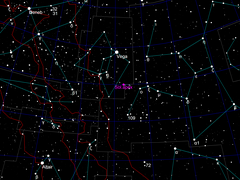Solar apex
This article needs additional citations for verification. (March 2013) |
| Solar apex |
|---|
 (RA) 18h 28m 0s (dec) 30°N |
| Solar antapex |
 (RA) 6h 28m 0s (dec) 30°S |

The solar apex, or the apex of the Sun's way, refers to the direction that the Sun travels with respect to the local standard of rest. This is not to be confused with the Sun's apparent motion through all constellations of the zodiac, which is an illusion caused by the orbit of the Earth.
Direction
The solar apex is in the constellation of Hercules, southwest of Vega, northeast of his "outstretched arm", Omicron Herculis.[1] There are two mainstream sets of coordinates for the solar apex.
- The visual coordinates (as obtained by visual observation of the apparent motion) are N
- in galactic coordinates: 56.24° longitude, +22.54° latitude
- in ecliptic coordinates: 271.79° longitude, +53.43° latitude.
- in
- The radioastronomical position is RA 18h 03m 50.2s, dec +30° 00′ 16.8″ (galactic coordinates: 58.87° longitude, 17.72° latitude).
Evaluation of movement of the Solar System in
For more than 30 years before 1986 the speed of the Sun towards the solar apex was taken to be about 20 km/s
History
The nature and extent of the solar motion was first demonstrated by William Herschel in 1783, who also first determined the direction for the solar apex, as Lambda Herculis, 10° away from today's accepted position.[5][6][7]
Solar antapex
The solar antapex, the direction opposite of the solar apex, is located near the star Zeta Canis Majoris.[1]
Gallery
- Animations of star motions around apex and antapex
-
The movement of stars around the apex (left) and antapex (right) in ± 500 000 years. To view this picture you need3D glasses(red-green or red-blue).
-
The movement of stars around the apex. To view this picture you need 3D glasses (red-green or red-blue).
-
The movement of stars around the antapex. To view this picture you need 3D glasses (red-green or red-blue).
-
The movement of stars between apex and antapex. To view this picture you need 3D glasses (red-green or red-blue).
See also
- W. W. Campbell
References
- ^ a b Kaler, Jim. "Furud". Retrieved 2017-04-26.
- S2CID 209835274.
- S2CID 15936627.
- ^ Frisch, Priscilla (2000); "The Galactic Environment of the Sun", American Scientist, volume 88, number 1, page 52
- ISBN 0-8153-0322-X.
- S2CID 186213288.
- S2CID 115478560.




